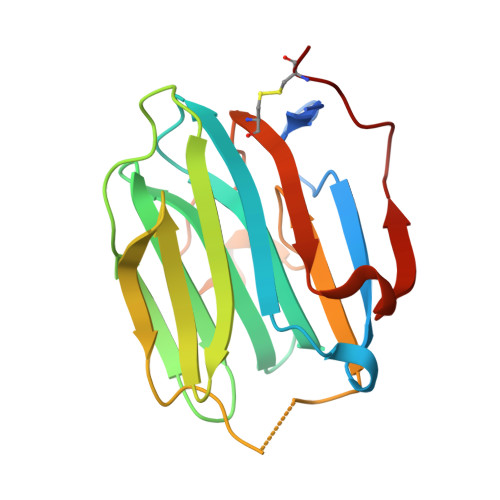Crystal structure of human sex hormone-binding globulin in complex with 2-methoxyestradiol reveals the molecular basis for high affinity interactions with C-2 derivatives of estradiol.
Avvakumov, G.V., Grishkovskaya, I., Muller, Y.A., Hammond, G.L.(2002) J Biological Chem 277: 45219-45225
- PubMed: 12228253
- DOI: https://doi.org/10.1074/jbc.M207762200
- Primary Citation of Related Structures:
1LHW - PubMed Abstract:
In a crystal structure of the amino-terminal laminin G-like domain of human sex hormone-binding globulin (SHBG), the biologically active estrogen metabolite, 2-methoxyestradiol (2-MeOE2), binds in the same orientation as estradiol. The high affinity of SHBG for 2-MeOE2 relies primarily on hydrogen bonding between the hydroxyl at C-3 of 2-MeOE2 and Asp(65) and an interaction between the methoxy group at C-2 and the amido group of Asn(82). Accommodation of the 2-MeOE2 methoxy group causes an outward displacement of residues Ser(128)-Pro(130), which appears to disorder and displace the loop region (Leu(131)-His(136)) that covers the steroid-binding site. This could influence the binding kinetics of 2-MeOE2 and/or facilitate ligand-dependent interactions between SHBG and other proteins. Occupancy of a zinc-binding site reduces the affinity of SHBG for 2-MeOE2 and estradiol in the same way. The higher affinity of SHBG for estradiol derivatives with a halogen atom at C-2 is due to either enhanced hydrogen bonding between the hydroxyl at C-3 and Asp(65) (2-fluoroestradiol) or accommodation of the functional group at C-2 (2-bromoestradiol), rather than an interaction with Asn(82). By contrast, the low affinity of SHBG for 2-hydroxyestradiol can be attributed to intra-molecular hydrogen bonding between the hydroxyls in the aromatic steroid ring A, which generates a steric clash with the amido group of Asn(82). Understanding how C-2 derivatives of estradiol interact with SHBG could facilitate the design of biologically active synthetic estrogens.
Organizational Affiliation:
Department of Obstetrics & Gynecology and Pharmacology, the Canadian Institutes of Health Research Group in Fetal and Neonatal Health and Development, the University of Western Ontario, London, Ontario N6A 4L6, Canada.



















